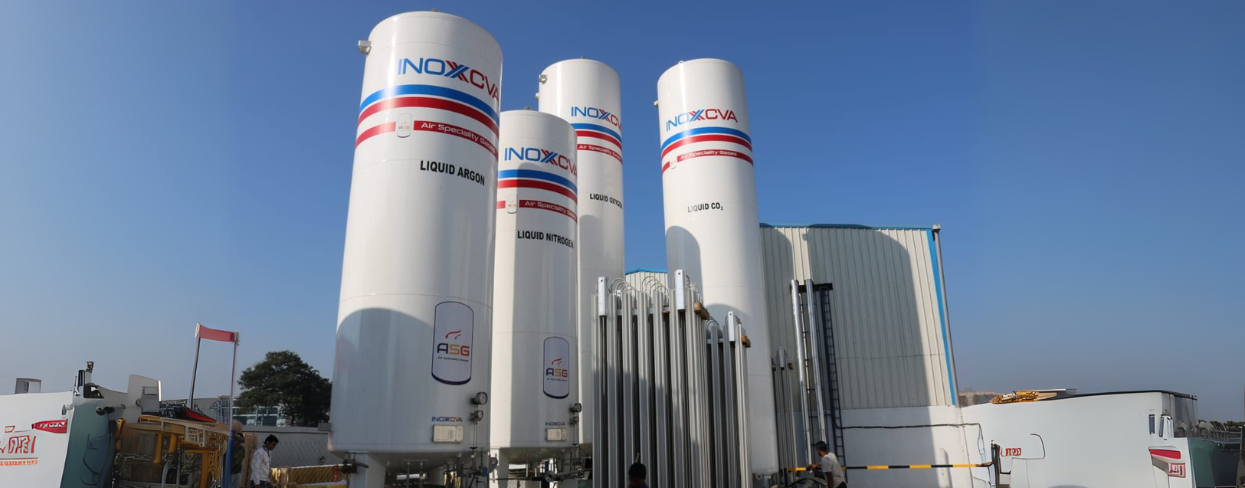What is Cryogenic?
“Cryogenic” refers to the science and technology of very low temperatures, typically below -150°C. At such temperatures, gases like oxygen, nitrogen, argon, and natural gas turn into liquids. These liquefied gases are easier to store and transport, but they demand specialized containment: cryogenic storage tanks.
Purpose and Applications of Cryogenic Storage Tanks
Cryogenic storage tanks are engineered to safely store liquefied gases while minimizing evaporation and maintaining stable internal conditions. You’ll find them in sectors such as:
- Medical (oxygen for hospitals)
- Energy (liquefied natural gas or LNG)
- Food processing (liquid nitrogen)
- Aerospace (liquid hydrogen)
- Industrial manufacturing and metal processing
Now, let’s look at how they’re made.
Anatomy of a Cryogenic Storage Tank
Understanding cryogenic storage tank design begins with its basic components:
Inner Vessel (Primary Container)
The inner vessel is the heart of the tank. It holds the liquefied gas and is typically made of stainless steel, a material known for its strength at low temperatures.
Insulation Layer
To prevent heat ingress and reduce boil-off (evaporation), a high-performance insulation layer is essential. Two common methods include:
- Vacuum insulation: The space between the inner and outer vessels is evacuated of air, drastically reducing heat transfer.
- Multi-layer insulation (MLI): Dozens of reflective layers further minimize thermal conduction.
Outer Vessel (Protective Shell)
This shell protects the tank from external damage and houses the insulation. It’s generally made of carbon steel or stainless steel.
Support System and Foundation
Flat-bottom tanks use reinforced concrete foundations, while smaller, mobile tanks use skid-mounted supports. Structural integrity is crucial to accommodate thermal contraction and expansion.
Cryogenic Storage Tank Design Considerations
Proper cryogenic storage tank design balances thermal performance, safety, and operational efficiency. Key design considerations include:
- Material selection: Alloys must maintain structural integrity at cryogenic temperatures.
- Thermal stress management: Designs must handle expansion and contraction.
- Safety systems: Pressure relief valves and gas detection sensors are standard.
- Boil-off management: Minimizing heat ingress helps reduce gas loss.
Advanced Welding Expertise for Cryogenic Solutions
INOXCVA excels in cryogenic tank welding and manufacturing, backed by advanced techniques and stringent quality controls. The company is renowned for producing vacuum-insulated cryogenic equipment for a wide range of gases, including liquid nitrogen, oxygen, argon, and others. Its credibility is further strengthened by ISO 3834-2 and ASME certifications, which highlight its commitment to global quality standards.
Key Aspects of INOXCVA’s Welding & Manufacturing:
-
Advanced Welding Practices
We deploy precision welding methods, including orbital welding for piping to ensure clean, contamination-free joints—crucial for cryogenic system integrity.
-
ISO 3834-2 Welding Quality Management
Our operations adhere to ISO 3834-2—Comprehensive quality requirements for fusion welding—ensuring end-to-end quality control across the welding process. This rigorous compliance was reaffirmed through successful audits at our Kandla facility.
-
ASME U-Stamp Re-Certification
Our Kalol and Kandla plants hold the ASME U-Stamp certification, underscoring our adherence to high safety and quality standards required for cryogenic pressure vessels.
-
Certifications & Global Standards
Our equipment meets a spectrum of international standards and certifications, including:
ASME (U & R Stamps)
ISO 3834-2
PED, TPED
CE marking
DOT-39, IMDG, UN T-50, ADR/RID, and more
These ensure suitability for safe, multimodal transport of cryogenic liquids. -
Material Proficiency
We work with a variety of low-temperature-rated materials, especially stainless steel and specialized alloys, to preserve mechanical strength at cryogenic temperatures and facilitate high-quality welds.
-
Focus on Quality and Innovation
Quality assurance is integrated at every stage, from raw material inspection to final inspection, making precision welding a pillar of our process. We offer both standard and fully customized tanks, often pioneering solutions in areas such as green energy and scientific research.
Why Choose INOXCVA Cryogenic Storage Tanks
Renowned for innovation and engineering excellence, INOXCVA Cryogenic Storage Tanks stand out for their durability, thermal efficiency, and application-specific customization. From mobile dewars to massive LNG storage units, INOXCVA continues to set industry benchmarks, delivering turnkey solutions that support industries worldwide.
Conclusion
Cryogenic storage tanks are feats of engineering, meticulously designed to handle extreme conditions. From their layered construction to advanced insulation systems, every element of cryogenic storage tank design ensures safe, efficient storage of liquefied gases.
Understanding what is cryogenic is the first step toward appreciating these silent workhorses of modern industry. With cutting-edge solutions from INOXCVA Cryogenic Storage Tanks, these tanks will continue to power sectors ranging from healthcare to energy, with reliability and performance built in.

